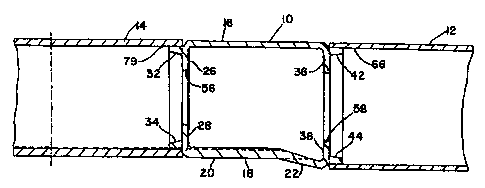Une partie des informations de ce site Web a été fournie par des sources externes. Le gouvernement du Canada n'assume aucune responsabilité concernant la précision, l'actualité ou la fiabilité des informations fournies par les sources externes. Les utilisateurs qui désirent employer cette information devraient consulter directement la source des informations. Le contenu fourni par les sources externes n'est pas assujetti aux exigences sur les langues officielles, la protection des renseignements personnels et l'accessibilité.
L'apparition de différences dans le texte et l'image des Revendications et de l'Abrégé dépend du moment auquel le document est publié. Les textes des Revendications et de l'Abrégé sont affichés :
| (12) Brevet: | (11) CA 2500055 |
|---|---|
| (54) Titre français: | ELEMENT DE TRANSITION DE TRAVERSE EXTREME POUR WAGON A MARCHANDISES |
| (54) Titre anglais: | RAILWAY FREIGHT CAR END SILL TRANSITION MEMBER |
| Statut: | Accordé et délivré |
| (51) Classification internationale des brevets (CIB): |
|
|---|---|
| (72) Inventeurs : |
|
| (73) Titulaires : |
|
| (71) Demandeurs : |
|
| (74) Agent: | GOWLING WLG (CANADA) LLP |
| (74) Co-agent: | |
| (45) Délivré: | 2008-07-08 |
| (22) Date de dépôt: | 2005-03-09 |
| (41) Mise à la disponibilité du public: | 2006-01-12 |
| Requête d'examen: | 2005-03-09 |
| Licence disponible: | S.O. |
| Cédé au domaine public: | S.O. |
| (25) Langue des documents déposés: | Anglais |
| Traité de coopération en matière de brevets (PCT): | Non |
|---|
| (30) Données de priorité de la demande: | ||||||
|---|---|---|---|---|---|---|
|
Il s'agit d'un élément de transition pour wagon de marchandises. L'élément de transition permet de relier les différentes sections transversales du châssis à la traverse de traction et au longeron central d'un wagon de marchandises. L'élément de transition est habituellement une structure unitaire en acier moulé, dotée généralement d'une section transversale rectangulaire ou carrée.
A transition member for use in a railway freight car is provided. The transition member provides connection between the dissimilar cross sections of the underbody and draft sill of the railway freight car and the center sill of the railway freight car. The transition member is usually a unitary cast steel structure and is of a generally rectangular or square cross section.
Note : Les revendications sont présentées dans la langue officielle dans laquelle elles ont été soumises.
Note : Les descriptions sont présentées dans la langue officielle dans laquelle elles ont été soumises.

2024-08-01 : Dans le cadre de la transition vers les Brevets de nouvelle génération (BNG), la base de données sur les brevets canadiens (BDBC) contient désormais un Historique d'événement plus détaillé, qui reproduit le Journal des événements de notre nouvelle solution interne.
Veuillez noter que les événements débutant par « Inactive : » se réfèrent à des événements qui ne sont plus utilisés dans notre nouvelle solution interne.
Pour une meilleure compréhension de l'état de la demande ou brevet qui figure sur cette page, la rubrique Mise en garde , et les descriptions de Brevet , Historique d'événement , Taxes périodiques et Historique des paiements devraient être consultées.
| Description | Date |
|---|---|
| Représentant commun nommé | 2019-10-30 |
| Représentant commun nommé | 2019-10-30 |
| Requête pour le changement d'adresse ou de mode de correspondance reçue | 2018-01-16 |
| Exigences relatives à la révocation de la nomination d'un agent - jugée conforme | 2010-06-23 |
| Exigences relatives à la nomination d'un agent - jugée conforme | 2010-06-23 |
| Inactive : Lettre officielle | 2010-06-22 |
| Demande visant la révocation de la nomination d'un agent | 2010-06-10 |
| Demande visant la nomination d'un agent | 2010-06-10 |
| Accordé par délivrance | 2008-07-08 |
| Inactive : Page couverture publiée | 2008-07-07 |
| Préoctroi | 2008-04-18 |
| Inactive : Taxe finale reçue | 2008-04-18 |
| Un avis d'acceptation est envoyé | 2008-03-11 |
| Un avis d'acceptation est envoyé | 2008-03-11 |
| Lettre envoyée | 2008-03-11 |
| Inactive : Approuvée aux fins d'acceptation (AFA) | 2007-12-20 |
| Modification reçue - modification volontaire | 2007-06-27 |
| Inactive : Dem. de l'examinateur par.30(2) Règles | 2007-03-15 |
| Demande publiée (accessible au public) | 2006-01-12 |
| Inactive : Page couverture publiée | 2006-01-11 |
| Inactive : CIB en 1re position | 2005-05-17 |
| Inactive : Certificat de dépôt - RE (Anglais) | 2005-04-14 |
| Exigences de dépôt - jugé conforme | 2005-04-14 |
| Lettre envoyée | 2005-04-14 |
| Lettre envoyée | 2005-04-14 |
| Demande reçue - nationale ordinaire | 2005-04-14 |
| Toutes les exigences pour l'examen - jugée conforme | 2005-03-09 |
| Exigences pour une requête d'examen - jugée conforme | 2005-03-09 |
Il n'y a pas d'historique d'abandonnement
Le dernier paiement a été reçu le 2008-01-21
Avis : Si le paiement en totalité n'a pas été reçu au plus tard à la date indiquée, une taxe supplémentaire peut être imposée, soit une des taxes suivantes :
Veuillez vous référer à la page web des taxes sur les brevets de l'OPIC pour voir tous les montants actuels des taxes.
Les titulaires actuels et antérieures au dossier sont affichés en ordre alphabétique.
| Titulaires actuels au dossier |
|---|
| ASF-KEYSTONE, INC. |
| Titulaires antérieures au dossier |
|---|
| JAMES A. GRAY |